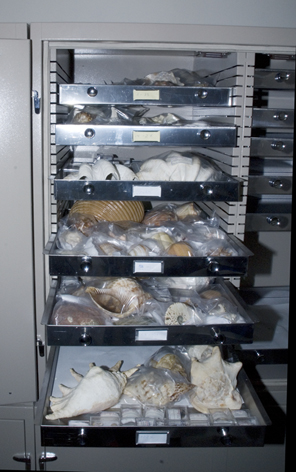Malacology
The Mollusk Collection of the MNCN
There are mollusks in the sea, land and fresh water. The number of mollusc species is far from being known, and there may be more than double the 80,000 species currently described.
The mollusc collection of the MNCN is eminently scientific, although with many historical specimens. The number of specimens is about 2,000,000, distributed in about 130,000 lots corresponding to 12,000 species. The collection conserves specimens of the 8 known classes of mollusks: 24 species of Solenogastra (240 described), 7 of Caudophoveata (150 described), 35 of Scaphopoda (800 described), 161 of Poliplacophora (1,000 described), 2 of Monoplacophora (30 described), 43 Cephalopoda (600 described), 1,705 Bivalvia (8,000 described) and 9,979 Gastropoda (60,000 described).
Although we have malacological material from all over the world, the best represented faunas are those of the Iberian Peninsula, the Philippines, Cuba, Equatorial Guinea and South America. The collections of terrestrial mollusks from Philippines, Cuba and Equatorial Guinea, as well as that of marine mollusks of the Conidae family, could be considered among the best in the world. In the collection of terrestrial and freshwater mollusks we have several extinct species. There is also an important representation of the fauna of south American mollusks from the "Comisión Científica del Pacífico", an expedition that took place between 1862 and 1866. There are very interesting our historical collections, the result of the work of people like Franco Dávila, whose collection dates back to the beginning of the Real Gabinete de Historia Natural, and other researchers such as Graells, Paz and Membiela, González Hidalgo, Azpeitia, Ortiz de Zárate and Cobos. Other malacological material has been deposited continuously by naturalists and scientists since King Carlos III started the Museum.
More than 85% of the lots are dry preserved, but there is also an important collection of specimens in ethanol, many of them likely for molecular studies. There are also preparations for optical and scanning microscopes, as well as an interesting pearl collection. Currently 60% of all this material is computerized.
See the list of the collection organized by families
There are 1,656 type specimens of mollusks, corresponding to more than 1,200 different species. This collection is fully computerized and organized in special cabinets. See the list of types ordered by classes and families. See list of types ordered by classes and families.
 |
The rest of the collection is kept in closets sorted alphabetically by families.
The formation of a mollusc didactic collection complementary to the research collection has recently begun, and in which the specimens, lacking associated data, are more appropriate for the exhibition or non-scientific studies. This didactic collection, still in formation, is currently composed of approximately 1,000 lots.
The growth of the collection is continuous, mainly thanks to research projects of the MNCN itself as well as new donations and legacies. It is worth noting the recent donation of the Javier Conde collection, with more than 25,000 lots. The computerization work of the lots is also done on a regular and continuous basis, as is the taxonomy update and the correction of possible errors associated with the specimen information. Therefore, visits by researchers who help update the taxonomy of their specialty groups are always welcome. There are 2,000 lots photographed, and new photographs are taken as they are requested. To obtain photographs of the collection, fill out and send this form.
Some of the data in the collection can be found in GBIF and GenBank. All queries that you want to make about the collection are always answered by the staff of the same.
All the material of the collections is capable of being provided for study and exhibitions to accredited personnel of Universities, Colleges, Museums and other centers dedicated to education and research.

